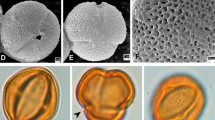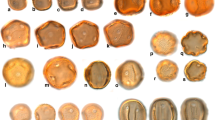Abstract
Pollen morphology of 25 species of the genus Euphrasia L., belonging to the family Orobanchaceae from Pakistan has been examined by light and scanning electron microscope. It is a stenopalynous genus. Pollen grains are usually radially symmetrical, isopolar, tricolpate, sub-prolate to prolate-spheroidal rarely oblate-spheroidal. Sexine slightly thinner than nexine or as thick as nexine. Tectum coarse to fine retipilate or rugulate–retipilate. On the basis of exine ornamentation three distinct pollen types viz., Euphrasia foliosa, Euphrasia multiflora, and Euphrasia incisa are recognized. Pollen morphology is significantly helpful at specific level within the pollen type.




Similar content being viewed by others
References
Abu Sbaih HA, Keith-Lucas DM, Jury SL (1994) Pollen morphology of the genus Orobanche L. (Orobanchaceae). Bot J Linn Soc 116:305–313
Argue CL (1980) Pollen morphology in the genera Mimulus and its taxonomic significance (Scrophulariaceae). Amer J Bot 67(8):68–87
Belkine KV (1972) New palynological data on taxonomy of Yakutian species of Pedicularis. Bot Zh 57:822–825
Bennett JR, Mathews S (2006) Phylogeny of the parasitic plant family Orobanchaceae inferred from Phytochrome A. Amer J Bot 93(7):1039–1051
Bolliger M, Wick L (1990) The pollen morphology of Odontites and its taxonomic significance. Pl Syst Evol 173:159–178
Davis PH, Heywood VH (1963) Principals of angiosperm taxonomy. Princeton, New Jersey
Doyle JA (1969) Cretaceous angiosperms pollen of the Atlantic coastal plain and its evolutionary significance. J Arnold Arbor 50:1–35
Erdtman G (1952) Pollen morphology and plant taxonomy. Angiosperm. Almqvist and Wiksell, Stockholm
Faegri K, lversen J (1964) Text book of pollen analysis, 2nd edn. Munksgaard, Copenhagen
Fischer E (2004) Scrophulariaceae. In: Kubitzki K, Kadereit JW (eds) The families and genera of vascular plants, vol 7. Springer-Verlag, Berlin, pp 333–432
Harley MM (1991) The pollen morphology of the Sapotaceae. Kew Bull 46:379–491
Holmgren PK, Holmgren NH, Barnel LC (1990) Index herbariorum, part 1: The Herbaria of the world, 8th edn. Regnum veg., New York
Hong D-Y, Yang H-B, Jin C-L, Holmgren NH (1998) Scrophulariaceae. In: Wu Z-Y, Raven PH (eds) Flora of China, vol 18. Science Press, Beijing, Missouri Botanical Garden Press, St Louis
Ikuse M (1956) Pollen grains of Japan. Hirokawa Publishing Co., Tokyo
Inceoglu O (1982) Pollen grains in some Turkish Rhinantheae (Scrophulariaceae). Grana 21:83–96
Kremp GOW (1965) Encyclopedia of pollen morphology. Univ. Arizona Press, Tuscon
Kuprianova LA (1969) On evolutionary levels in the morphology of pollen grains and spores. Pollen et Spore 11:333–351
Lu L, Wang H, Blackmore S, Li DZ, Dong LN (2007) Pollen morphology of the tribe Rhinantheae (Orobanchaceae) and its systematic significance. Plant Syst Evol 268:177–198
Mabberley DI (1987) The plant book. Camb. Univ. Press, New York
Minkin JP, Eshbaugh WH (1988) Pollen morphology of the Orobanchaceae and Rhinanthoid Scrophulariaceae. Grana 28:1–18
Moore PD, Webb JA (1978) An illustrated guide to pollen analysis. Hodder and Stoughton, London
Natarajan AT (1957) Studies in the morphology of pollen grains—Tubiflorae. Phyton 8:21–42
Punt W (1976) Evolutionary trends in the pollen grains of Dichapetalaceae. In: Ferguson IK, Muller J (eds) The evolutionary significance of exine. Academic press, NewYork, pp 327–377
Qaiser M, Siddiqui T, Shaukat SS (2011) Two new species of Euphrasia (Orobanchaceae) from Pakistan and adjoining areas. Pak J Bot 43(4):1809–1818
Rao TS (1963) Pollen morphology of two species of Orobanchaceae. Curr Sci 32:557–558
Siddiqui T, Qaiser M (1991) The genus Euphrasia from Pakistan and its adjoining areas. In: Ali SI, Ghaffar A (eds) Plant life of South Asia, Department of Botany, University of Karachi, Karachi, pp 127–147
Siddiqui T, Qaiser M, Shaukat SS (1989) A numerical taxonomic study of Euphrasia paucifolia complex Scrophulariaceae from Pakistan and adjoining areas. Candollea 44(2):521–530
Toderich KN, Shuyskaya EV, Ozturk M, Juylova A, Gismatulina L (2010) Pollen morphology of some asiatic species of genus Salsola (Chenopodiaceae) and its taxonomic relationships. Pak J Bot 42:155–174 [Special issue (S.I. Ali Festschrit)]
Tsoong PC, Chaung RT (1965) Palynological study of Pedicularis and its relation with taxonomic systems of the genus. Acta Phytotaxon Sinicia 10:257–281
Van Campo M (1976) Patterns of pollen morphological variation within taxa. In: Ferguson IK, Muller J (eds) The evolutionary significance of the exine. Academic Press, London
Varghese TM (1968) Studies in the family Scrophulariaceae-II pollen morphology. J Palynol 4:91–97
Walker JW (1976) Evolutionary significance of the exine in the pollen of primitive angiosperms. In: Ferguson IK, Muller J (eds) The evolutionary significance of the exine. Academic Press, New York, pp 251–308
Wodehouse RP (1965) Pollen grains (31d print). Hafner Publ co., New York
Yeo PF (1956) Hybridization between diploid and tetraploid species of Euphrasia. Watsonia 3:253–269
Yeo PF (1966) The breeding relationships of some European Euphrasia. Watsonia 1:216–245
Yeo PF (1978) A taxonomic revision of Euphrasia in Europe. Bot J Linn Soc 77:223–334
Young ND, Steiner KE, Depamhilis CW (1999) The evolution of parasitism in Scrophulariaceae/Orobanchaceae: plastid gene sequences refute an evolutionary transition series. Ann Mo Bot Gard 86:876–893
Author information
Authors and Affiliations
Corresponding author
Rights and permissions
About this article
Cite this article
Qaiser, M., Perveen, A. & Siddiqui, T. Pollen morphology of the genus Euphrasia L. (Orobanchaceae) from Pakistan and Kashmir and its taxonomic significance. Plant Syst Evol 300, 483–492 (2014). https://doi.org/10.1007/s00606-013-0897-4
Received:
Accepted:
Published:
Issue Date:
DOI: https://doi.org/10.1007/s00606-013-0897-4




